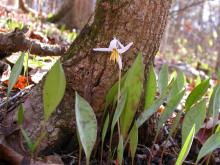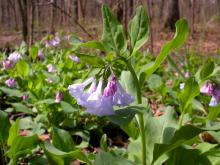Wildflowers, Grasses and Other Nonwoody Plants
Media

Species Types
Scientific Name
Ageratina altissima (formerly Eupatorium rugosum)
Description
White snakeroot looks very similar to thoroughworts, but it has triangular leaf blades that are more broadly angled or rounded at the base. White snakeroot is common statewide. It’s a toxic plant if eaten, so it’s good to be able to identify it.
Media

Species Types
Scientific Name
Eupatorium altissimum
Description
A stout perennial that can grow to 6 feet tall, tall thoroughwort is a member of the sunflower family that has dull white flowers and distinctive leaves that are opposite, slender, very short-stalked, and with three quite noticeable veins.
Media

Species Types
Scientific Name
Liatris aspera
Description
Rough blazing star is fairly common and scattered nearly statewide. To distinguish between Missouri’s nine species in the genus Liatris, start by noting details of the flower structure. It’s not hard when you know what to look for.
Media

Species Types
Scientific Name
Conoclinium coelestinum (formerly Eupatorium coelestinum)
Description
Mist flower, or wild ageratum, is a vigorous native perennial bearing fluffy-looking, bluish-purple flowerheads. It looks quite a bit like the annual ageratum that is sold as a bedding plant in garden centers.
Media

Species Types
Scientific Name
Geranium maculatum
Description
Called “crane’s bill” for its sharply pointed seed capsules, wild geranium is a gardening favorite, and there are cultivated varieties of this woodland wildflower bred for unique petal and leaf colors.
Media

Species Types
Scientific Name
Hydrophyllum appendiculatum
Description
Woollen breeches bears clusters of light blue, bell-shaped flowers. The lower leaves of this hairy plant are shaped something like maple leaves and often have grayish or light green marks that look like water stains.
Media

Species Types
Scientific Name
Ruellia strepens
Description
Although the funnel-shaped, 5-lobed flowers look something like the petunias you find at garden centers, our wild petunia is not related to them. This ruellia often has crinkled hairs in 2 narrow, lengthwise bands on opposite sides of the stalk.
Media

Species Types
Scientific Name
Perilla frutescens
Description
Introduced as an ornamental, beefsteak plant is native to Asia. It is common in moist or dry wooded bottomlands, open valley pastures, and along trails, railroads, and roadsides. It spreads invasively in our state.
Media

Species Types
Scientific Name
Erythronium albidum
Description
White dogtooth violet, or white trout lily, is a small, early blooming lily that lives in wooded areas. Its flowers are white and its narrow leaves are purplish or brownish mottled. They are often found as a colony of blade-shaped, green-and-brown-mottled leaves poking out of the earth in spring, with only a few producing flowers.
Media

Species Types
Scientific Name
Mertensia virginica
Description
One of our most stunning early spring wildflowers, bluebells is also a popular native plant for gardening. As with all native plant gardening, make sure you get your plants from ethical sources.
See Also
About Wildflowers, Grasses and Other Nonwoody Plants in Missouri
A very simple way of thinking about the green world is to divide the vascular plants into two groups: woody and nonwoody (or herbaceous). But this is an artificial division; many plant families include some species that are woody and some that are not. The diversity of nonwoody vascular plants is staggering! Think of all the ferns, grasses, sedges, lilies, peas, sunflowers, nightshades, milkweeds, mustards, mints, and mallows — weeds and wildflowers — and many more!





















